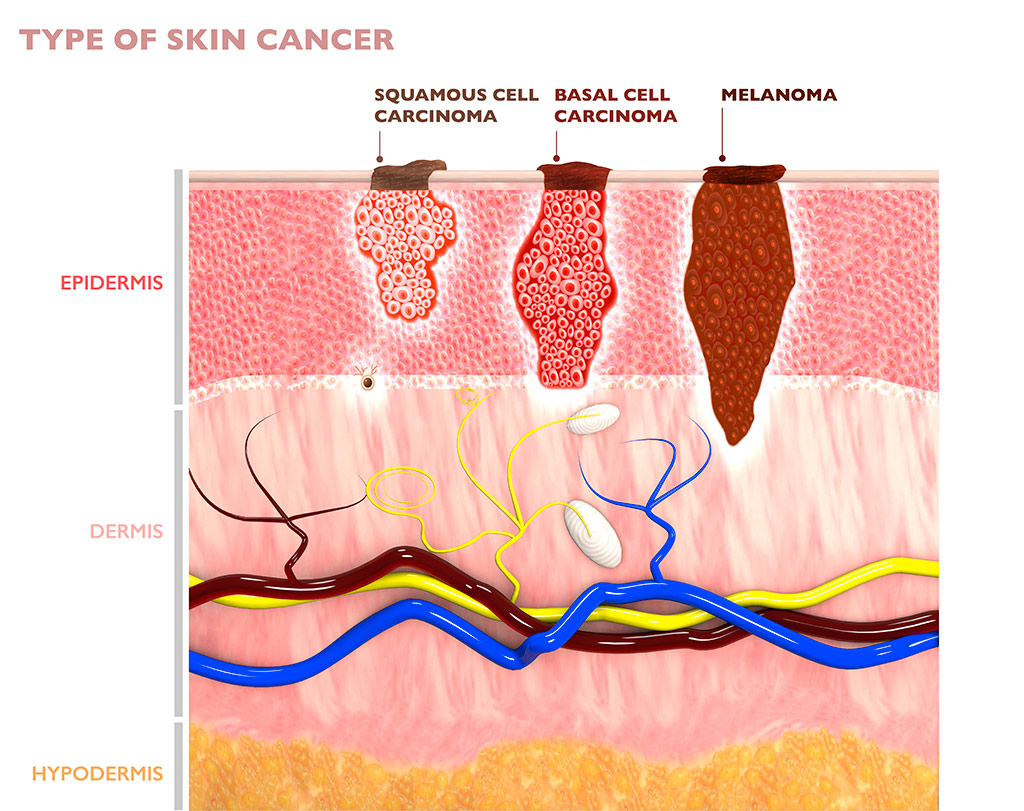Menu
From Expert Diagnoses To Treatment And Beyond
We’re all at risk for skin cancer. In fact, one in five Americans will develop skin cancer at some point in their life. The most common types are basal cell carcinoma, squamous cell carcinoma and melanoma. The good news is that skin cancer is highly curable when diagnosed and treated early and that you can limit your risks of developing it by practicing sun safety.
Skin cancers can be divided into two types non-melanoma (basal and squamous cell carcinomas) and melanoma, with melanoma being the least common and most aggressive.

Basal cell carcinoma is the most common form of skin cancer, affecting cells of the deepest layer of the epidermis. This type of skin cancer typically appears on your skin as abnormal growths that resemble a waxy bump, sore or scar. They are the result of long-term exposure to the UV rays of the sun (or tanning beds) and often occur on the areas of your skin that have been most exposed, such as your face and neck. Basal cell carcinoma is slow growing and rarely metastasizes. However if it is left untreated, it has the potential to invade your healthy surrounding tissue.
Squamous cell carcinoma is a skin cancer that occurs in the uppermost layers of the skin or the epidermis. This type of skin cancer often looks like scabs, with a crusty patch growing on top of inflamed, red skin. Primarily caused by years of UV exposure, squamous cell skin cancer is most commonly found on areas of the body that are exposed to the sun, but they can also develop on the inside of the mouth, nose and genitalia.
Melanoma is the most serious form of skin cancer and can be fatal if left untreated. It can occur anywhere on the body when the skin cells that produce pigment mutate and grow rapidly, forming a tumor that resembles a mole or develops from a mole. Atypical moles (or dysplastic nevi) can sometimes mimic the appearance of melanoma, so schedule an examination to be sure. Be diligent about self-checking your moles and look for the ABCDE signs of melanoma, especially if you have ever experienced a sunburn or have a family history of this cancer. Melanoma is serious and can spread quickly to other parts of the body.
This surgical procedure is often used to treat small basal cell and squamous cell skin cancers. During this procedure we will scrape the tumor with a curette, a surgical instrument shaped like a long spoon, and then use an electric needle to cauterize the remaining cancer cells and some normal-looking tissue.
For many people diagnosed with non-melanoma skin cancers, like basal cell carcinoma and squamous cell carcinoma, this has become the preferred treatment option. Mohs surgery is widely accepted as the most effective method for removing certain types of skin cancer, with a cure rate of 97 to 99 percent for basal and squamous cell carcinomas.
Mohs surgery is performed by our board-certified Mohs surgeons, who precisely remove the cancer in stages, layer by layer, while preserving as much healthy surrounding tissue as possible.
Each thin layer of skin is immediately examined under the microscope as it is removed in order to detect any remaining cancerous cells. If cancer cells are present, the surgeon removes another thin layer of the skin. This layer-by-layer approach continues until the cancer cells can no longer be found, removing the cancer down to its roots. Once the edges are cancer-free, the wound is repaired and closed.
This advanced technology for treating non-melanoma skin cancer and keloid scarring is ideal for patients 60 and older. Image-guided SRT enables our dermatologists and certified radiation therapists to define each lesion’s boundaries and margins to fully optimize our patients’ treatment plans.
Cryosurgery is a simple, non-invasive procedure in which liquid nitrogen is used to freeze and destroy growths on the surface of the skin. It’s an effective treatment for precancerous skin lesions (actinic keratoses) as well as a range of skin conditions, including warts, skin tags and moles.
Applying liquid nitrogen to skin lesions and growths allows our specialists to specifically target the damaged areas and destroy them at the cellular level. After freezing, the affected area will scab over and should heal within three to six weeks. Our team uses cryosurgery to treat a wide range of conditions. It offers a number of advantages: it’s a simple, affordable outpatient procedure; it’s mildly uncomfortable; and it has a low risk of infection.
Chemotherapy applied to the skin: The generic name for the medicine used in this treatment is 5-fluorouracil or 5-FU. The patient applies 5-FU to the skin cancer. It destroys the damaged skin cells, and when the skin heals, new skin appears.
We are proud to have received this distinction for our service to the military.

Privacy Policy | ©2024 Southeastern Dermatology Group, P.A. All Rights Reserved. Dermatology Solutions Group, LLC